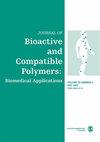利用3d打印氧化石墨烯/透明质酸/壳聚糖复合支架改善成骨性能
IF 2.1
4区 生物学
Q3 BIOTECHNOLOGY & APPLIED MICROBIOLOGY
引用次数: 4
摘要
口腔颌面部肿瘤、外伤和感染是造成颌骨缺损的主要原因,其临床治疗十分复杂。随着生物组织工程的发展,许多生物材料在口腔医学的各个领域得到了广泛的应用,在颌面骨缺损的修复和置换中发挥着非常重要的作用。在本研究中,我们拟制备不同氧化石墨烯质量比的氧化石墨烯/透明质酸/壳聚糖(GO/HA/CS)复合水凝胶:0.1% (0.1% GO/HA/CS)、0.25% (0.25% GO/HA/CS)、0.5% (0.5% GO/HA/CS)、1% (1% GO/HA/CS),通过3d打印技术将其制备成多层稳定的复合支架,通过扫描电镜(SEM)观察复合支架的表面形貌,然后测试其理化性能、力学性能、水溶胀率、体外降解等材料性能。通过细胞形态学观察、细胞粘附、细胞增殖、活死细胞染色等实验,研究了GO/HA/CS复合支架的生物学性能。结果表明:通过化学交联和3d打印技术,可成功构建多孔(孔径450 ~ 580 μm)、多层的GO/HA/CS生物支架,其表面为相互连接的微孔结构,孔隙率随着GO含量的增加逐渐降低(94% ~ 40%)。同时,随着氧化石墨烯浓度的变化,支架的水溶胀率、降解率、弹性模量等力学性能也有所改善。此外,添加适量氧化石墨烯的复合支架几乎没有细胞毒性,可以促进细胞生长和增殖,特别是0.25%氧化石墨烯/HA/CS复合支架。因此,0.25%氧化石墨烯/HA/CS复合支架具有优异的生物材料性能,与成骨细胞具有良好的生物相容性,为修复颌骨缺损提供了新的思路。本文章由计算机程序翻译,如有差异,请以英文原文为准。
Improvement of osteogenic properties using a 3D-printed graphene oxide/hyaluronic acid/chitosan composite scaffold
Oral and maxillofacial tumors, trauma and infections are the main causes of jaw defects, whose clinical treatment is very complicated. With the development of biological tissue engineering, many biological materials have been widely used in various fields of stomatology, and they play a very important role in the repair and replacement of maxillofacial bone defects. In this study, we intended to prepare a graphene oxide/hyaluronic acid/chitosan (GO/HA/CS) composite hydrogel with different mass ratios of GO: 0.1% (0.1% GO/HA/CS), 0.25% (0.25% GO/HA/CS), 0.5% (0.5% GO/HA/CS), and 1% (1% GO/HA/CS), prepare it into a multilayered and stable composite scaffold through 3D-printing technology, observe the surface morphology of the composite scaffold through scanning electron microscopy (SEM), and then test its physical and chemical properties, mechanical properties, water swelling rate, in vitro degradation and other material properties. Moreover, the biological performance of the GO/HA/CS composite scaffold was studied through experiments, such as cell morphology observation, cell adhesion, cell proliferation, and live-dead cell staining. The results showed that through chemical cross-linking and 3D-printing technology, a porous (pore size: 450–580 μm) and multilayered GO/HA/CS biological scaffold could be successfully constructed, and its surface was an interconnected microporous structure, and the porosity decreased (94%−40%) gradually with the increase of GO. Meanwhile, with the change in GO concentration, some mechanical properties of the scaffold could be improved, such as water swelling rate, degradation rate, and elastic modulus. In addition, the composite scaffold with the appropriate amount of GO had almost no cytotoxicity and could promote cell growth and proliferation, especially 0.25% GO/HA/CS composite scaffold. Consequently, the 0.25% GO/HA/CS composite scaffold had excellent biological material properties and good biocompatibility with osteoblasts, which may provide a new idea for the repair of jaw defects.
求助全文
通过发布文献求助,成功后即可免费获取论文全文。
去求助
来源期刊

Journal of Bioactive and Compatible Polymers
工程技术-材料科学:生物材料
CiteScore
3.50
自引率
0.00%
发文量
27
审稿时长
2 months
期刊介绍:
The use and importance of biomedical polymers, especially in pharmacology, is growing rapidly. The Journal of Bioactive and Compatible Polymers is a fully peer-reviewed scholarly journal that provides biomedical polymer scientists and researchers with new information on important advances in this field. Examples of specific areas of interest to the journal include: polymeric drugs and drug design; polymeric functionalization and structures related to biological activity or compatibility; natural polymer modification to achieve specific biological activity or compatibility; enzyme modelling by polymers; membranes for biological use; liposome stabilization and cell modeling. This journal is a member of the Committee on Publication Ethics (COPE).
 求助内容:
求助内容: 应助结果提醒方式:
应助结果提醒方式:


